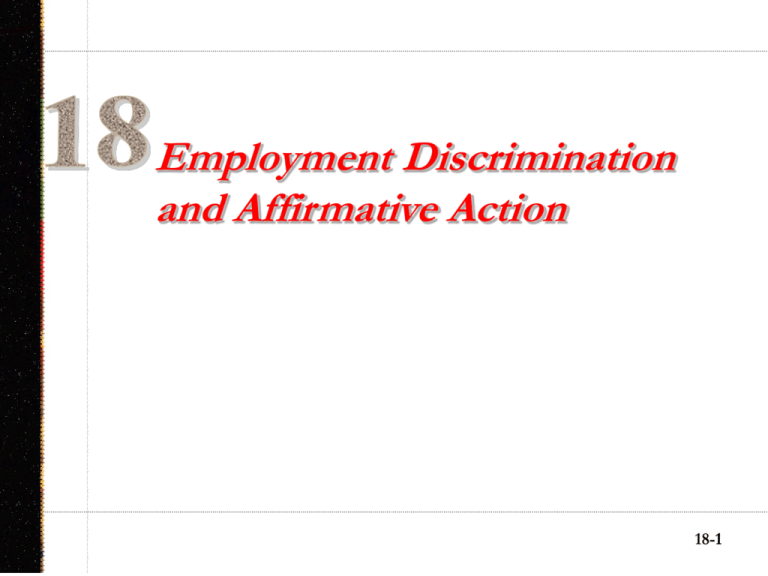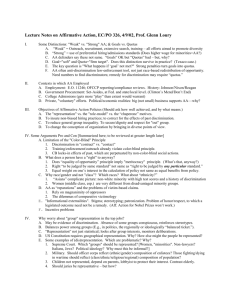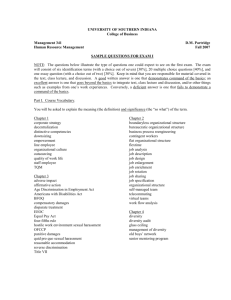
Employment Discrimination
and Affirmative Action
18-11
Chapter Eighteen Objectives
•
•
•
•
Chronicle the civil rights movement
Outline the federal discrimination laws
Provide two different meanings of discrimination
Elaborate on employment discrimination relating
to race, color, national origin, sex, age, religion,
and disability.
• Identify the different postures with respect to
affirmative action, the concept of reverse
discrimination, and an overview of the Supreme
Court’s decisions
18-22
Chapter Eighteen Outline
•
•
•
•
•
•
The Civil Rights Movement and Minority Progress
Federal Laws Prohibiting Discrimination
Expanded Meanings of Discrimination
Issues in Employment Discrimination
Affirmative Action in the Workplace
Summary
18-3
Introduction to Chapter Eighteen
The chapter addresses:
• Civil rights movement
• Civil rights issues as those rights relate to
employment
• Federal discrimination laws
• Affirmative action
18-4
Civil Rights Movement
The Civil Rights Movement of 1950s and
1960s, the Women’s Movement of
Minorities and women,
the 1970s, and groups seeking
older people, people
to remove other forms of discrimination have resulted in protected
with disabilities, gays
groups—stakeholders whose
and lesbians and others
rights are protected by antihave received or still
discrimination laws.
seek certain workplace
rights that should be
protected.
18-5
Federal Anti-Discrimination Laws
Title VII of the Civil Rights Act of 1964: Prohibits discrimination in
hiring and other aspects of employment on the basis of race, color,
religion, sex, or national origin.
Age Discrimination in Employment Act of 1967: Protects
workers 40 years old and older from arbitrary age discrimination.
Equal Pay Act of 1963: Prohibits sex discrimination in payment of
wages to women and men who perform substantially equal work.
Rehabilitation Act of 1973, Section 503: Prohibits job
discrimination on the basis of a handicap.
Americans with Disabilities Act: Gives individuals with disabilities
civil rights protections similar to those given to individuals on the
basis of race, sex, national origin, and religion.
Civil Rights Act of 1991: Provided increased financial damages
and jury trials in cases of intentional discrimination.
18-6
Federal Anti-Discrimination Laws
Equal Opportunity Commission
• Five Commissioners
– President appoints and Senate confirms
• Purpose
– Sets equal employment opportunity policy
– Investigates employment discrimination complaints
– Enforces anti-discrimination laws
18-7
Expanded Meanings of
Discrimination
• Disparate Treatment
• Disparate Impact
– Griggs v. Duke Power Company
18-8
Expanded Meanings of Discrimination
Treatment
Direct discrimination
Impact
Indirect discrimination
Rules with a
Unequal consequences or
discriminatory premise
results
Intentional discrimination Unintentional
discrimination
Prejudiced actions
Neutral, color-blind
actions
Varying standards for
Same standards, but
different groups
different consequences for
different groups
18-9
New Issues Impacting
Employment Discrimination
Two Nations of Black America
In the aftermath of the Civil Rights
Era, two African-America
communities now exist side by
side, an affluent, professional, and
well-educated middle class, and a
large underclass with a
disproportionate
number in
prison.
Two New Groups: Asians
and Hispanics
Hispanic population growth in
the workforce is steadily
rising—and their needs are
different from African
Americans. Asian American
presence is also rising in the
workforce, as is the problem
of their being perceived as a
“model minority.”
18-10
New Issues Impacting
Employment Discrimination
• Hispanics
• Asians
18-11
New Issues Impacting
Employment Discrimination
• Getting into professional and managerial positions
and out of traditional female-dominated positions
• Achieving pay commensurate with men
• Eliminating sexual harassment
– Quid pro quo
– Hostile work environment
• Being able to take maternity leave without losing
jobs or job status
18-12
New Issues Impacting
Employment Discrimination
18-13
Sexual Harassment
Sexual harassment has now broadened to include not only
individuals of the opposite sex, but of the same sex, too.
Allegations of sexual harassment against public figures in the
political, military, and corporate spheres, continue to create new
ethical and legal problems.
18-14
New Issues Impacting
Employment Discrimination
Suggested Sexual Harassment Guidelines
•
•
•
•
•
Educate employees about prohibited conduct
Reexamine, revise, and reissue written policy
Make employees aware: redress procedures
Introduce, or update training programs
Make certain that environmental harassment is
absent from the workplace
• Get input from female employees
18-15
New Issues Impacting
Employment Discrimination
• Maternity leave
– Pregnancy Discrimination Act
• Fetal protection policies
– UAW v. Johnson Controls, Inc.
• Issues of age and religion
– Age Discrimination Act
18-16
Affirmative Action Postures
Weak
1. Passive nondiscrimination. A
willingness in hiring, promotion,
and pay decisions to treat the
races and the sexes alike.
2. Pure affirmative
action. A concerted effort
to enlarge the pool of
applicants so that no one
is excluded because of
past or present
discrimination.
STRONG
3. Affirmative action with
preferential hiring. A
company systematically
favors minorities and
women in the actual
decisions of enlarging its
labor pool.
4. Hard quotas. A company
specifies numbers or proportions
of minority group members that
must be hired.
18-17
Affirmative Action in the
Workplace
• Preferential Treatment
– Compensatory justice
• Reverse discrimination
• Minority opposition to affirmative action
• Affirmative action and the courts
– Strict scrutiny
• Compelling government interest
• Narrowly tailored to meet interest
• Future of affirmative action
18-18
Selected Key Terms
• Affirmative action
• Age discrimination
• Americans with Disabilities
Act (ADA)
• Bona fide occupational
qualification
• Civil Rights Act of 1964
• Civil Rights Act of 1991
• Disparate treatment
• Disparate impact
• Equal Opportunity
Commission (EEOC)
• Equal Pay Act
• Fetal protection
• Preferential treatment
• Protected groups
• Reverse discrimination
• Sexual harassment
• Title VII
18-19







